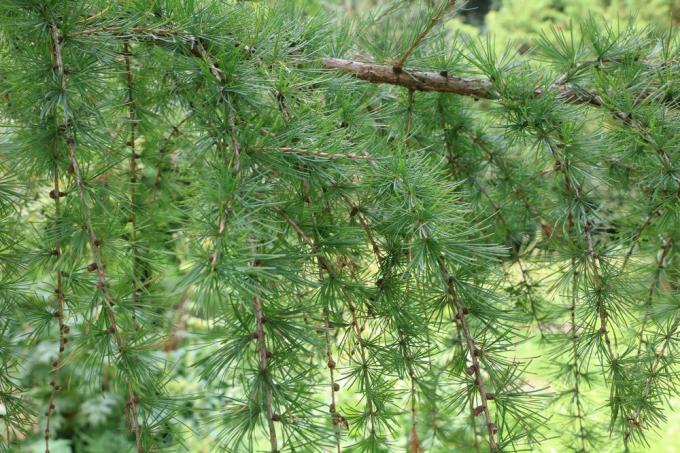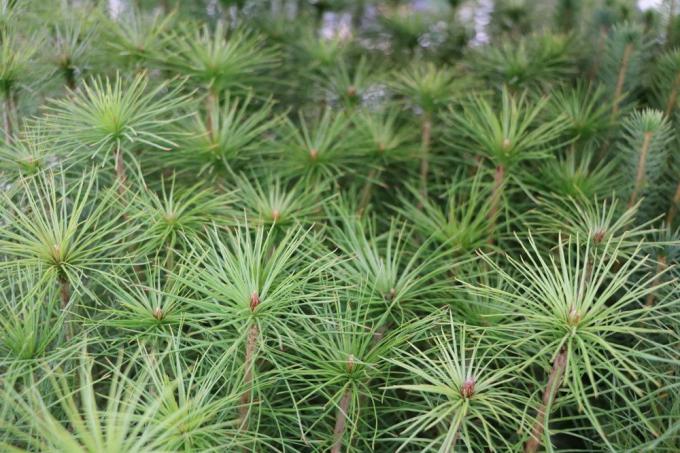
table of contents
- Conifer species
- Spruce trees (Picea)
- Yew family (Taxaceae)
- Cypress family (Cupressaceae)
- Pine (Pinus)
- Firs (Abies)
- Larch
Conifers have been around for over 270 million years. They too belong to the group of shrubs and trees, just like deciduous trees. A mix-up is usually hardly possible due to the distinctive foliage. They are evergreen, with a few exceptions. For many people, conifers stand for winter, Christmas and cosiness. These conifers have found their way into the home garden for many years. They are available in different variations.
Conifer species
Conifers are usually evergreen with a few exceptions such as the larch (latrix). For this reason, they are often used in the garden as Hedge plants. They grow easily, are easy to care for and adaptable. However, it should be borne in mind that different conifer species can reach heights of up to 30 meters and higher.
Note: Especially with very tall conifers and also hedge plantings, it is essential to keep the distance to the neighboring property in order to avoid later disputes. Information about this can be obtained from the public order offices of the cities and municipalities.
Spruce trees (Picea)
There are about 50 different types. The hardy ones Shallow root can reach a height of between 30 and 70 meters and can live up to 500 years. Their growth is shrub-like with a conical crown and a trunk diameter of up to one meter. The bark is somewhat scaly and red to brown in color. The evergreen round needles can reach a length between 2 and 5 centimeters. They are very pointed and sting. Appearing cones are initially greenish in color, later brown and 10 to 15 centimeters long. Compared to the fir, these hang down on the branches. There are a few things to consider when planting:
- sunny location
- Soil: rich in humus, sandy-loamy, nutrient-rich, moist and permeable
- Cut not necessary
- Growth height up to 3000 cm
- Spread 100 to 300 cm
- annual growth 25 to 40 cm
Blue spruce (Picea pungens)
The beautiful ornamental tree is also very often referred to as the blue fir. It has a pyramidal habit. The steel-blue, square and prickly needles are a particular eye-catcher. These are densely packed on tiered branches. From the beginning of April to the end of April, spike-shaped yellow flowers appear. Yellow-brown cones develop from this. The blue spruce is particularly suitable as a solitary planting, then it is also branched to the ground.
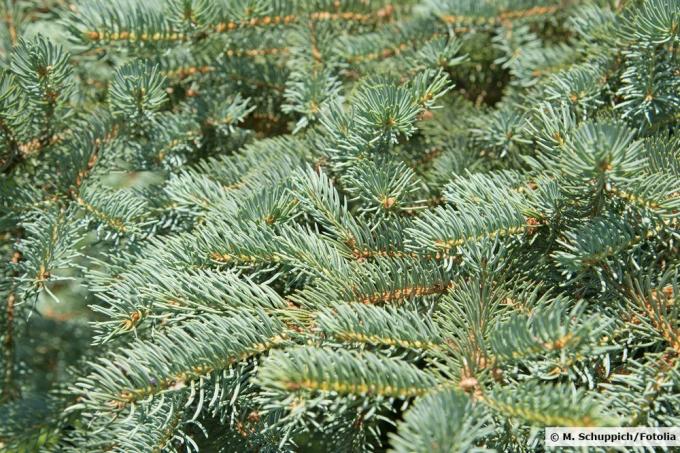
Serbian Spruce (Picea omorika)
The growth of these spruces is compact, dense and narrow. The even branches are crescent-shaped and directed upwards. Dark green, shiny needles 8 to 18 millimeters long are firmly attached to the branches. There are white stripes on the underside. The 5 centimeter large cones are initially purple and later red-brown in color. Serbian spruces are suitable as hedge plants, also for solitary positions.
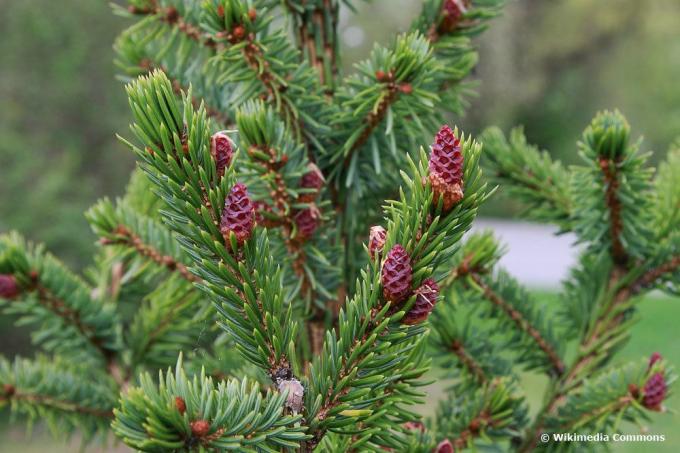
Yew family (Taxaceae)
There are over 80 types. Yew plants are evergreen and their plant parts are all poisonous. They can reach heights of up to 15 meters and very old will. The needle-shaped, flattened and flexible leaves are alternate on the branches. They are lighter colored on the underside. The bark is scaly to fibrous and reddish brown. The trees are undemanding and easy to care for:
- Use alone or as a hedge
- sunny to partially shaded place
- Soil: slightly calcareous, rich in nutrients
- Height of growth 200 to 1500 cm
- Spread 70 to 800 cm
- annual growth of 20 to 30 cm
- hardy
- cut compatible and malleable
- 3 plants per meter when planted in hedges
European yew tree (Taxa baccata)
The evergreen yew trees can be grown as a tree or shrub. The crown is broadly spherical to round and the branches reach to the ground. The growth is bushy and upright and densely branched. Young specimens grow with a single stem, while older ones can have several stems. The needles are soft, very flexible and up to 3 cm long. The top is dark green, a little lighter on the underside. The berries that appear are actually red, fleshy seeds. All plant parts are highly poisonous.

Cypress family (Cupressaceae)
The growth can vary from species to species. It ranges from small, low lying to large upright shrubs. The branches are horizontal with mostly drooping shoot tips. Young plants have needle-shaped leaves and with age they are more like scales. They are green to dark green and lie close to the branches. The cones are up to 8 centimeters in size and often brown in color. Dark blue to black berry cones develop from this.
- sunny to partially shaded location
- Soil: fresh, dry, moderately rich in nutrients, permeable to water, slightly acidic
- Growth height up to 1200 cm
- Spread 200 to 600 cm
- annual growth of 15 to 30 cm
- hardy and undemanding
- when planting in hedges, 2 to 3 plants per meter
- cut compatible
Common Juniper (Juniperus communis)
He is also as Heather juniper known, evergreen and grows as a shrub or small tree. The crown is narrow and conical. There is a continuous leading instinct. The needles are always three pieces around the branch in whorls. They are up to 2 cm long, stiff, blue and sting. The cones are initially greenish. They take three years to mature and then turn black. You are as Juniper berries known. There are several types and varieties, also with different colors.

Tree of Life (Thuja)
The tree of life is mainly used as a hedge plant. The conifers have arched ascending branches with a conical crown. Scale-shaped leaves are close to the shoots. In the wild species, they are dark green. Various were created through breeding colored species. The tenons have a conical shape. Male cones are reddish and female light green to light brown. All plant parts are poisonous.
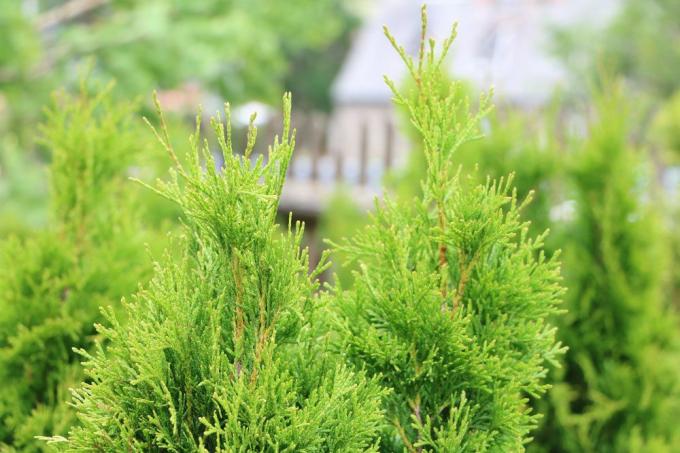
False cypress (Chamaecyparis)
They are closely related to the "real cypress" and are evergreen. Their growth is slender and conical. All parts of the plant are poisonous. Due to their dense growth, they are used as hedge plants. However, they are also suitable as a single plant or for container culture. There are also several brightly colored types.
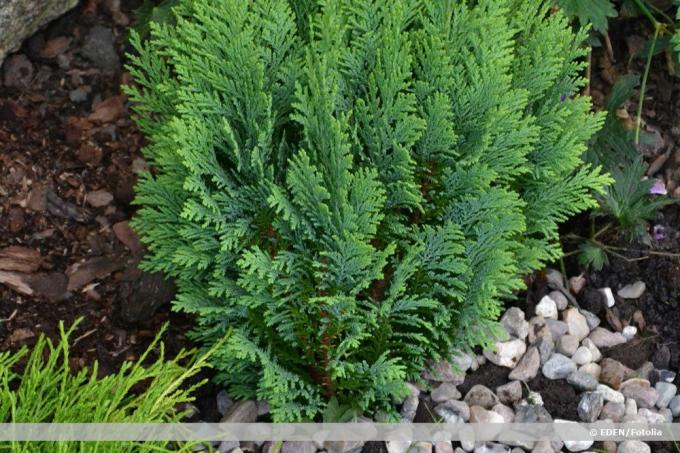
Pine (Pinus)
In the garden are mainly Dwarf forms used. The branches are irregularly shaped and studded with blue-green needles. The leaf position is two-needle. The crown is broad and umbrella-shaped. Impressive, candle-like, light yellow flowers appear in April / May. Brown cones then develop from this. Pines are ideal for single planting. It is important here
- location in full sun
- Soil: nutrient-rich, moist, well-drained
- no strong cutting measures
- Growth height 1000 to 3500 cm
- Spread 700 to 1500 cm
- annual growth 15 to 40 cm
- hardy
Dwarf pine (Pinus mugo pumilio)
The conifers have a pillow-shaped to flat-spherical growth. The dwarf pine can reach a height of up to 150 cm. It is very slow growing, with an annual increase of 5 to 7 centimeters. Egg-shaped to spherical cones appear. This species can be used in many ways, but is also excellent for one Culture in the bucket suitable.

Silver pine (Pinus sylvestris)
It is also known as the shrub woodland pine. The growth form is semicircular, in old age it tends to be umbrella-like and can reach a height of 600 centimeters and width. it is very slow growing with an annual increase of 10 to 12 centimeters. The needles are very short and colored blue-gray to steel blue. These sturdy conifers should be planted individually.
Firs (Abies)
There are around 50 types of fir trees. They have a columnar trunk with a conical crown. The short branches are attached to several levels. The bark is smooth and often gray to silver in color. Firs are evergreen, deep-rooted and can reach heights of up to 70 meters. The flat, needle-shaped leaves are flexible and stand flat on the branch. There are two white wax strips on the underside. However, cones only appear on the top branches. They are initially greenish, later reddish brown and 10 to 15 centimeters long and 5 centimeters wide. Note the following when planting:
- sunny to partially shaded location
- Soil: rich in humus, slightly acidic, permeable to water, evenly moist
- no cutting measures necessary
- Growth height 1000 to 2500 cm
- Spread 800 to 1500 cm
- annual growth 10 to 40 cm
- hardy
Korean fir (Abies koreana)
The growth is conical with a straight trunk to the tip. The branch structure is included bushy and the side branches are horizontal. They are covered with dense, shiny needles up to 1 cm long, blunt at the ends. The top is dark green and silvery underneath. The bark is shiny olive brown to black in color. The blue-purple cones appear at a height of less than 150 cm. They stand upright on the branches from September until winter.
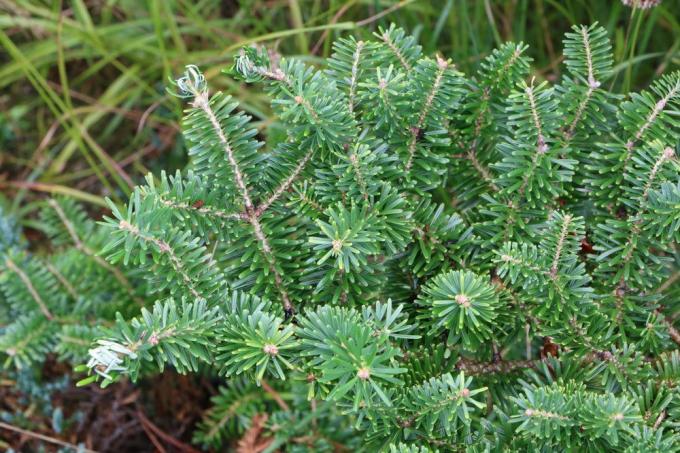
Nordmann fir (Abies nordmanniana)
These conifers are also known as the Caucasian fir. They have a pyramidal habit with spreading branches to the ground and thereby a dense needle dress. The needles are arranged like a brush upwards on the branches. The top is green and there are two silvery-white stripes on the underside. The Nordmann fir is particularly suitable for solitary planting.
Larch
These deciduous Conifers can reach heights between 10 and 40 meters. They have a conical shape. The bark is gray to brown and scaly. Light green, soft needles up to 3 centimeters long stand together in dense clusters like rosettes. Their ends are flattened. Pink to red flowers appear in April. Light brown, egg-shaped cones then develop from this. However, in autumn the needles are thrown off. When planting, please note:
- sunny location
- Soil: moist, deep, fresh, loamy
- pH slightly acidic to slightly alkaline
- no cut
- Growth height 1500 to 4000 cm
- Spread 700 to 1500 cm
- annual growth 25 to 50 cm
European larch (Larix decidua)
It can reach a height of 35 meters with a straight trunk and a conical crown. The branches stand horizontally, are sometimes slightly overhanging and covered with light green needles 1 to 3 centimeters soft. A golden yellow color then takes place in autumn. The larch is suitable for stand alone but also for high hedges.
